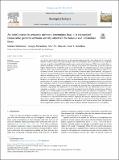An item's status in semantic memory determines how it is recognized : dissociable patterns of brain activity observed for famous and unfamiliar faces
Abstract
Are all faces recognized in the same way, or does previous experience with a face change how it is retrieved? Previous research using human scalp-recorded Event-Related Potentials (ERPs) demonstrates that recognition memory can produce dissociable brain signals under a variety of circumstances. While many studies have reported dissociations between the putative ‘dual processes’ of familiarity and recollection, a growing number of reports demonstrate that recollection itself may be fractionated into component processes. Many recognition memory studies using lexical materials as stimuli have reported a left parietal ERP old/new effect for recollection; however, when unfamiliar faces are recollected, an anterior effect can be observed. This paper addresses two separate hypotheses concerning the functional significance of the anterior old/new effect: perceptual retrieval and semantic status. The perceptual retrieval view is that the anterior effect reflects reinstatement of perceptual information bound up in an episodic representation, while the semantic status view is that information not represented in semantic memory pre-experimentally elicits the anterior effect instead of the left parietal effect. We tested these two competing accounts by investigating recognition memory for unfamiliar faces and famous faces in two separate experiments, in which same or different pictures of studied faces were presented as test items to permit brain activity associated with retrieving face and perceptual information to be examined independently. The difference in neural activity between same and different picture hits was operationalized as a pattern of activation associated with perceptual retrieval; while the contrast between different picture hits and correct rejection of new faces was assumed to reflect face retrieval. In Experiment 1, using unfamiliar faces, the anterior old/new effect (500–700 ms) was observed for face retrieval but not for perceptual retrieval, challenging the perceptual retrieval hypothesis. In Experiment 2, using famous faces, face retrieval was associated with a left parietal effect (500–700 ms), supporting the semantic representation hypothesis. A between-subjects analysis comparing scalp topography across the two experiments found that the anterior effect observed for unfamiliar faces is dissociable from the left parietal effect found for famous faces. This pattern of results supports the hypothesis that
Citation
MacKenzie , G , Alexandrou , G , Hancock , P J B & Donaldson , D I 2018 , ' An item's status in semantic memory determines how it is recognized : dissociable patterns of brain activity observed for famous and unfamiliar faces ' , Neuropsychologia , vol. 119 , pp. 292-301 . https://doi.org/10.1016/j.neuropsychologia.2018.08.004
Publication
Neuropsychologia
Status
Peer reviewed
ISSN
0028-3932Type
Journal article
Description
This work was supported by a grant from the Biotechnology and Biological Sciences Research Council, United Kingdom (BB/L023644/1).Collections
Items in the St Andrews Research Repository are protected by copyright, with all rights reserved, unless otherwise indicated.

